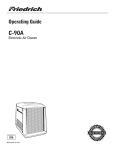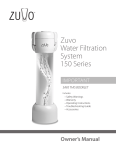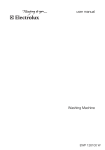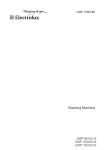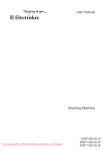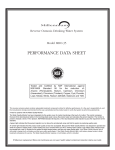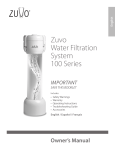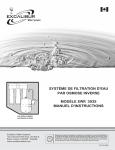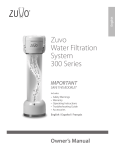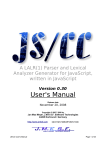Download White 4075 Instruction manual
Transcript
REVERSE OSMOSIS WATER FILTRATION SYSTEM MODEL EWR 4075 INSTRUCTION MANUAL Excalibur Water Systems 142 Commerce Park Drive, Unit M & N Barrie, Ontario L4N 8W8 CANADA www.excaliburwater.com 2013.05.7446 4-Stage RO System REQUIRED TOOLS & MATERIALS • • • • • • Tape Measure Phillips Head Screwdriver Adjustable Wrench File Pencil Pan or Bucket • • • • • • Utility Knife 1/8” & 1/2” Drill Bits Center Punch Safety Glasses Masking Tape Drill PACKAGE CONTENTS Sediment Cartridge Carbon Cartridge Reverse Osmosis Membrane Carbon Cartridge Angle Valve Adapter S C RO C Teflon® Tape Tank Valve W Drain Fitting U 6’ of 1/4” White Tube 1 V Faucet Adapter PLAN FOR INSTALLATION Prior to installation, we recommend you read the entire manual. This will not only familiarize you with the system, but it will help you determine the best location for installation whether under a sink or in a remote location. Helpful diagrams follow. PREPARE SITE FOR INSTALLATION 1 Prior to starting, close the cold water shut-off valve. 2 Temporarily place tank and filter assembly into cabinet to ensure adequate space and proper positioning. 3 Remove tank and filter from cabinet and set aside. INSTALLATION OVERVIEW There are eight easy steps to installing your RO unit. They are as follows: Step 1 - Install Angle Valve Adapter Step 2 - Install RO Drain Connector Step 3 - Install RO Filter Assembly Step 4 - Install Water Storage Tank Step 5 - Install Tank Valve Step 6 - Install RO Faucet Step 7 - Connect Tubing Step 8 - Install RO System and Drain in Remote Location Step 9 - Sanitize, Pressure Test, Purge System NOTE: You must check and comply with all local plumbing codes. STANDARD INSTALLATION 1/4” White Tube to Drain 1/4” White Tube to Reverse Osmosis Carbon Cartridge Reverse Osmosis Membrane Carbon Cartridge Angle Valve Adapter Sediment Cartridge Tank Valve S C RO C Restrictor 2 REMOTE INSTALLATION (requires nearby water source and drain) 3/8” White Tube to Faucet 3/8” White Tube to Tank 1/4” White Tube to Drain Point 2” Minimum STEP ONE – INSTALL ANGLE VALVE ADAPTER 1 Identify the cold water line in the sink cabinet. Turn off the cold water supply to the sink. 2 Turn on the kitchen faucet to release pressure and allow water to completely drain from the line. 3 Disconnect the cold water line from the lower shut off valve. Note: You may need to shorten the supply line pipe using a hacksaw or pipe cutter to accommodate the Adapter if pipe is rigid. 4 Holding the Angle Valve Adapter in an upright position (see diagram in Package Contents on page 1), screw onto the threaded shut off valve. 5 Screw the cold water supply line to the male threads of the Adapter using the nut that was previously connecting the cold water line to the shut off valve. 3 Angle Valve Adapter STEP TWO – INSTALL RO DRAIN CONNECTOR ! WARNING ! Be sure that all electrical appliances and outlets are turned off at the circuit breaker before working in the cabinet area. 1 2 3 4 5 6 CAUTION Please wear safety glasses to protect eyes when drilling. Identify drain outlet location. From back of foam seal, remove protective cover. Knock center hole out, align holes, and attach to front plate of drain connector. Allowing room for drilling, position the drain connector on sink drain pipe above drain trap. Securely tighten nuts and screws. Using drain connector port as drill guide, drill 7/32” hole through wall of drain pipe. Be sure not to penetrate opposite side of pipe, and be careful not to damage side of drain port fitting. Angle Valve Adapter STEP THREE – INSTALL RO FILTER ASSEMBLY 1 Select easily accessible area under sink to mount system manifold. Note: Allow 4-6” clearance below the filter to the floor to allow ample space for filter changes. 2 Mark holes for mounting screws using built-in bracket on back of manifold. 3 Drill two pilot holes for mounting brackets using 1/8” drill bit.* 4 Insert mounting screws into the wall leaving approximately 3/8” of each screw exposed. 5 Hang manifold on mounting screws. * ! CAUTION Use caution not to drill into anything beyond the cabinet wall. 4 STEP FOUR – INSTALL WATER STORAGE TANK H Teflon® Tape Tank Valve 1 On the nipple on top of the tank, apply 2-3 wraps of Teflon® tape. 2 Hand-tighten the tank valve onto the tank nipple 3-4 times. Note: do not cross thread or over-tighten. 3 Using mount stand, place tank next to system assembly. STEP FIVE – INSTALL RO FAUCET You will need a sink top hole 1/2” in diameter. Note: Drilling holes into solid surfaces or surfaces made of stone should only be performed by a qualified and certified installer. 1 Ensure faucet body will mount flat against surface. 2 Place faucet base assembly on countertop and mark. 3 Drill ½” hole through countertop. 4 Fasten faucet to countertop. 5 Apply 2-3 wraps of Teflon® Tape to faucet. 6 Thread on faucet adaptor. Faucet Adapter 3/8” White Tube to Faucet 1/4” White Tube to Drain 1/4” White Tube to Reverse Osmosis 5 Carbon Cartridge Reverse Osmosis Membrane Carbon Cartridge Angle Valve Adapter Sediment Cartridge 3/8” White Tube to Tank S C RO C Restrictor STEP SIX – CONNECT TUBING Install tubing for water supply line from angle valve adapter to manifold inlet. Note: Do not bend or crimp tubing during this step. 1 With utility knife, cut the 1/4" white tubing squarely to desired length. 2 With water, wet one end of tubing and push into the angle valve adapter approximately 5/8” until it stops. 3 Wet other end of tubing and push into the manifold “INLET” approximately 5/8” until it stops. Note: It is not necessary to remove tubing for routine maintenance and filter exchanges, however, it may easily be disconnected if necessary. To disconnect, turn off water supply to system and press in white collar around fitting while pulling tubing out with other hand. Install tubing for water supply line from manifold outlet to faucet. 1 Identify length of 3/8”white tubing necessary to connect to manifold outlet labeled “FAUCET” to faucet adapter. 2 Cut tubing squarely with utility knife. Do not discard remaining tubing. 3 With water, wet one end of tubing and push into manifold outlet labeled “FAUCET” approximately 5/8” until it stops. 4 With water, wet other end of tubing, push into faucet adapter approximately 5/8” until it stops. Connect tubing from manifold to tank. 1 Use remaining white tubing set aside earlier and identify length needed to connect tank outlet labeled “TANK” on manifold to tank. 2 Cut white tubing square with a utility knife. 3 Insert tubing into port of tank valve (previously connected to tank) and tighten tank valve nut. 4 Insert other end of white tubing into outlet of manifold labeled “TANK” approximately 5/8” until it stops. Note: For servicing, tubing lengths should allow for removal of assembly from mount screws. 6 STEP SIX – CONNECT TUBING (Continued) Drain fitting to Restrictor. 1 Locate membrane drain port on lower membrane side. 2 By pushing down on the white collar while pulling plug with other hand, remove black plug from membrane filter drain port. 3 Identify length necessary to connect to drain port. 4 With utility knife, cut the 1/4" white tubing squarely to desired length. 5 Insert restrictor into end of white tubing. 6 Insert white tubing into fitting on bottom of membrane filter approximately 5/8” until it stops. 7 Gently tug on white tubing to ensure it is firmly seated in fitting. 1/4” White Tube to Drain Carbon Cartridge Reverse Osmosis Membrane Carbon Cartridge Angle Valve Adapter Sediment Cartridge Tank Valve S C RO C 1/4” White Tube to Reverse Osmosis Restrictor Connect flow restrictor to drain adapter connection. 1 Attach 1/4" tubing to collet quick connect on flow restrictor. 2 Cut enough 1/4” white tubing to route in as straight as possible without any twists, kinks, loops or valleys. 3 Cut end of 1/4” white tubing with utility knife to desired length. 4 Insert 1/4” white tubing to drain connection approximately 5/8" until it stops. 5 Gently tug on white tubing to ensure it is firmly seated in fitting. 7 NOTE: THIS STEP FOR REMOTE LOCATIONS ONLY STEP SEVEN – INSTALL RO SYSTEM & DRAIN 1 Determine if tubing is long enough to reach drain. If yes, insert restrictor in end of tubing and insert this end into drain port on membrane. If no, replace with tubing of adequate length and insert restrictor into end of tubing. Insert this end of tubing into drain port on membrane. 2 Cut enough 1/4” white tubing to drain port. 3/8” 3/8” Restrictor 1/4” White Tube to Drain Point 2” Minimum 8 STEP EIGHT – SANITIZE, TEST & PURGE Sanitize Note: Sanitization is recommended immediately after RO Filter System installation and any inner-part servicing. The person sanitizing should have clean hands during this process. 1 Shut off water supply to RO system. 2 Open faucet. If tank is not empty, allow to drain until empty. 3 With included eyedropper and household bleach (5.25%), disconnect white tubing from tank valve. Note: Bleach needs to be handled according to manufacturer’s instructions. 4 Add 3ml bleach into open end of tank white tubing. 5 Reconnect tank and white tubing to tank valve. 6 Sanitization will be completed during the following pressure test and purge. Important: Bleach must be completely removed from system before drinking water. See Purge instructions below. Pressure Test Important: Complete sanitization prior to pressure test. 1 2 3 4 Open cold water supply valve to RO Filter System. To purge air from the plumbing system, open kitchen faucet. Close faucet when water runs smooth. Confirm RO faucet is closed. Within approximately 2 hours, pressure will start to build in the RO Filter System. Carefully inspect all connections and fittings while this pressure buildup occurs. 5 Check for leaks. If leaks are found, fix by ensuring all tubing is cut squarely and fully inserted. Also confirm there are no scratches, dents or notches at tubing end. If there are, squarely cut 1” off and re-insert. Purge 1 Open RO faucet and let water flow through system for 24 hours. Note: Flow rate will be slow during this time. 2 Close RO faucet after purge is complete. Note: Your RO Filter System is ready for use when purge is complete, however, you will not have filtered water immediately. It takes 1 – 3 hours to completely fill the tank. The flow rate will be less than your kitchen faucet. Water will run to the drain while the RO Filter System is filtering water – even when not in use. This is normal. Water going to drain will stop automatically when tank is at capacity. 9 Filter Replacement 1 Close angle valve located on cold water supply hose to shut off water supply to the RO Filter System. 2 Turn cartridge from right to left until unit releases. Gently pull down to remove from head. Discard used cartridge. Note: Place a bucket or pan under system to catch any water drips. 3 Hold new cartridge with label slightly facing left. The two nozzles on top of cartridge should be toward the back of the Filter System, and the two extended flanges should be out to each side. Note: Part No. SMFPP2005TL should be in stage 1, Part No. SMF CBC2005TL should be in stages 2 and 4, and Part No. ROTWRM75 should be in stage 3. 4 Lift cartridge straight up into the manifold until the two nozzles seat into the manifold ports, and the two extended flanges are flush with the manifold. 5 Turn cartridge from left to right until it stops. 6 Turn on cold water shut-off valve and RO faucet. Check for leaks. 7 Pressure test and Purge per Step Eight. 10 4-STAGE RO SYSTEM – MODEL EWR 4075 U.S. Metric Membrane Production1 75 ± 7 gpd (283 ± 26 lpd) Membrane TDS Reduction1 96.6% minimum 96.6% minimum System Production2 45 gpd 170 lpd TDS Reduction2 97.5%+ typical 97.5%+ typical Maximum TDS 1000 ppm 1000 ppm Maximum water hardness @ 6.9pH 10 gpg 2.64 gpL Maximum Chlorine in water 3.0 ppm 3.0 ppm Supply water pH limits 4-10 4-10 Drain (reject water) Flow 3-5 x product flow 3-5 x product flow Empty Storage Tank Precharge 5-7 psi air 35-48 kPa air Storage Tank Capacity2 4.0 gallons 15 liters Supply water pressure limits 40-100 psi 280-689 kPa Supply water temperature limit 40-100⁰ F 5-40⁰ C Efficiency3 19% 19% Recovery 4 30.6% 30.6% Specifications – Qualified System Performance Because the performance of a Reverse Osmosis Membrane is highly dependent upon pressure, temperature and TDS, the following should be used for comparison purposes only. 1. Industry standards measure RO Membranes performance with no back pressure on the product water, at 60 psig (414kPa) and 77°F (25°C). Further conditions on the above are 250 ppm TDS and a 30.6% recovery rate. Production rate and TDS reduction figures are for a new Membrane that has been rinsed for 24 hours. The production rate of a new Membrane can decrease by 10% per year or more, depending upon the scaling and fouling tendencies of the Feed Water. 2. Measured at 50 psi, 77°±2°F, and 717 mg/l TDS per NSF/ANSI Standard 58. 3. Efficiency rating means the percentage of the influent water to the system that is available to the user as reverse osmosis treated water. Under operating conditions that approximate typical daily usage. 4. Recovery rating means the percentage of the influent water to the membrane portion of the system that is available to the user as reverse osmosis treated water when the system is operated without a storage tank or when the storage tank is bypassed. 11 Non-potable Water Sources: Do not attempt to use this product to make safe drinking water from non-potable water sources. Do not use the system on microbiologically unsafe water, or water of unknown quality without adequate disinfection before or after the system. This system is certified for cyst reduction and may be used on disinfected water that may contain filterable cysts. Arsenic Reduction: This system shall only be used for arsenic reduction on chlorinated water supplies containing detectable residual free chlorine at the system inlet. Water systems using an inline chlorinator should provide a one minute chlorine contact time before the reverse osmosis system. Installations in The Commonwealth of Massachusetts: The Commonwealth of Massachusetts requires installation be performed by a licensed plumber and do not permit the use of saddle valves. Plumbing code 248--CMR of the Commonwealth of Massachusetts must be followed in these cases. The product water shall be tested periodically to verify the system is performing satisfactorily. Product Water Testing: The Reverse Osmosis System contains a replaceable membrane cartridge critical for the effective reduction of total dissolved solids (TDS). Replacement of the reverse osmosis membrane cartridge: The reverse osmosis system contains a replaceable membrane cartridge critical to the efficiency of the system. This membrane should be replaced every 18 months, or more often based on your local water. Only replace the reverse osmosis membrane with a part approved for use in your Reverse Osmosis system. 12 SYSTEM MAINTENANCE Prefilter/Postfilter The pre-filters (sediment- stage 1 and carbon - stage 2) and post-filter (carbon - stage 4) are replaceable cartridges, and it is recommended replacing these every 6 months. You may need to replace more often with high water usage or high sediment level. Replacing these cartridges timely will protect the RO membrane from high levels of chlorine and/or sediment. As these filters build up with sediment, you may notice slower water output. RO Membrane Cartridge The RO membrane is located in stage 3. This membrane is a tightly wound membrane which reduces the dissolved solids and organic matter. Cartridge life depends on pH and supply water hardness. Higher pH shortens membrane life by causing pin-hole leaks. When output water quality and production rate decrease, it is time to replace the membrane cartridge, typically after 24 months. Flow rate and output are determined by 3 factors: 1 Incoming water temperature 2 Total dissolved solids (TDS) present in supply water 3 Incoming water pressure Lower temperatures are directly proportional to slower flow rate. All membranes are tested at 77°F. Incoming water temperature should not exceed 100°F. The RO Filter System should also not be installed in a location susceptible to freezing. The more TDS in the supply water, greater filter time is required. Incoming TDS should not exceed 1000 ppm. Higher water pressure enables a higher flow rate. Pressure must be above 40 psi for proper system operation. You may consider installing a permeate pump or booster pump if your pressure is below 40 psi. RO Cartridge Replacement 1 2 3 4 5 Remove the pre-filter cartridges first to relieve pressure on the RO filter. Turn RO filter to left and remove. Remove post-filter cartridge. Discard cartridges. Install new cartridges in reverse order turning to the right to secure: a – Post-filter (stage 4) b – RO membrane (stage 3) c – Pre-filter (stage 2) d – Pre-filter (stage 1) 6 Purge RO Filter System as outlined in Step Eight. 13 Pre-Filter & Post-Filter Cartridge Replacement 1 2 3 4 Remove pre-filter cartridge by turning to the left. Remove post-filter cartridge by turning to the left. Discard cartridges. Install new cartridges in reverse order by turning to the right: a – post-filter b – pre-filters 5 Purge RO Filter System as outline in Step Eight. Drain Flow Restrictor The restrictor is vital for proper operation of the RO membrane cartridge as it keeps water flowing through the membrane at the proper rate ensuring the water produced is the best quality. It is recommended the restrictor assembly be periodically inspected to be sure it is clean and unrestricted. If service is required on the drain flow assembly, disassemble and reassemble as outlined in Step Six. 14 Excalibur Water Systems 142 Commerce Park Drive, Unit M & N Barrie, Ontario L4N 8W8 CANADA www.excaliburwater.com
















